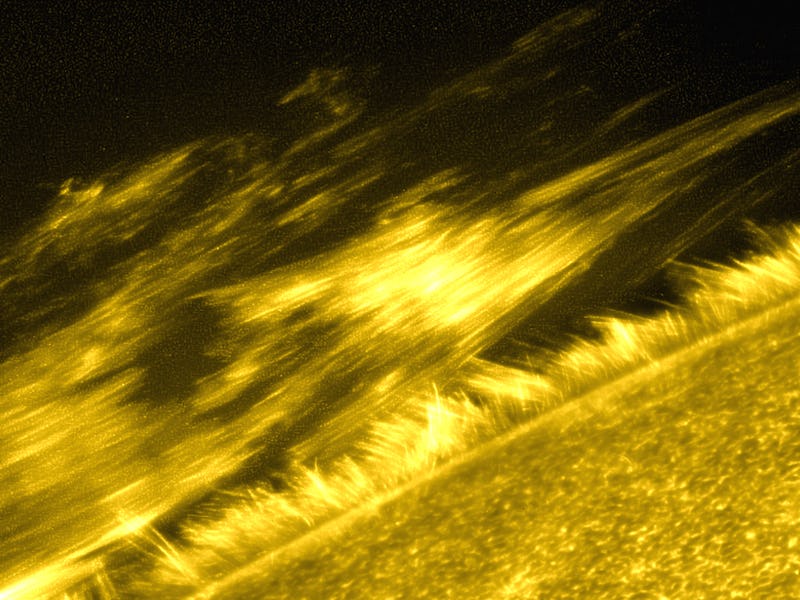The Sun's midlife crisis could be making it stand out in the universe
Our host star may be going through a midlife crisis

We already knew that the Sun was pretty special, this bright ball of glowing gases sustains life on Earth by providing light and energy for living things to survive.
But now, a study proves that the Sun's uniqueness isn't just in our heads, a result of it being the only star humanity has ever known. Even amongst a celestial sea of stars just like it, the Sun truly stands out.
The study, published Thursday in the journal Science, compared the Sun to 369 solar-like stars, and found that the Sun seems to be quite different from other stars that share its same properties. The new insight into our host star reveals what the Sun may evolve into in the future, and how that would affect us here on Earth, or that the Sun may simply be going through a 'midlife crisis.'
The Sun is much less active than other stars of its kind as illustrated in this comparison between our host star and one of the 369 stars used for the study.
"We wanted to see if the Sun is somehow different," Timo Reinhold, a researcher at the Max Planck Institute for Solar System Research in Germany, and lead author of the study, tells Inverse. "People have claimed that it’s more quiet than other stars, while others have claimed that it's similarly active so we wanted to really boil it down to this very solar-like sample that is very similar to the Sun."
The team of researchers behind the new study used four years worth of observations by the Kepler Space Telescope to measure the variations in brightness of 369 stars that shared the same properties as the Sun, such as its mass, temperature, composition and rotation period. They then compared these observations with the Sun's own brightness variations.
The results revealed that the other stars were on average five times more active than the Sun.
Solar activity partially depends on the Sun's magnetic field. The Sun's brightness reflects on changes in the magnetic fields, whereby changes in the star's magnetic fields leads to fluctuations in its brightness. The Sun's magnetic field may also be responsible for its mysterious 11-year cycle.
Every 11 years, the Sun’s magnetic field goes through a periodical cycle in which the south and north poles essentially switch spots. Towards the end of this cycle, the Sun’s activity starts to increase, with more solar flares and material bursting out into space.
"The solar dynamo is one of the last unsolved mysteries of solar physics," Reinhold says. "We don’t really know why it’s 11 years long, or how it is generated."
Other stars also run on cycles, but theirs varies from three years to eight years.
Although the researchers aren't quite sure what makes the Sun so unique, they have a few possible explanations.
One possibility is that the Sun will become this active at some point in the future, and that the other stars are merely at a different phase of their life cycle. However, that could happen anywhere between 10,000 years to a million years, or even 10 million years, the researchers aren't quite sure.
However, they do know that if that should happen and the Sun becomes as active as the other 369 stars used for the study, it would have implications for us on Earth.
At some point during its current 11-year-cycle, the Sun will eject boiling-hot plasma, in the form of solar flares, across the Solar System. If the Sun were to become more active, then these high-energetic events could possibly occur more frequently and have more energetic flares.
These solar storms disrupt communications on Earth, and affect orbiting satellites.
"Another explanation is the the Sun is in its midlife crisis," Reinhold says.
The Sun has been around for around 4.5 billion years, that's around a halfway point for a star's lifecycle. Therefore, the researchers hypothesize that perhaps stars hit some kind of transition at their midlife point where they become less active, sort of like us humans.
"These active stars have not made this transition yet and are therefore still active," Reinhold says.
Abstract: The magnetic activity of the Sun and other stars causes their brightness to vary. We investigated how typical the Sun’s variability is compared with other solar-like stars, i.e., those with near-solar effective temperatures and rotation periods. By combining 4 years of photometric observations from the Kepler space telescope with astrometric data from the Gaia spacecraft, we were able to measure photometric variabilities of 369 solar-like stars. Most of those with well-determined rotation periods showed higher variability than the Sun and are therefore considerably more active. These stars appear nearly identical to the Sun except for their higher variability. Therefore, we speculate that the Sun could potentially also go through epochs of such high variability.